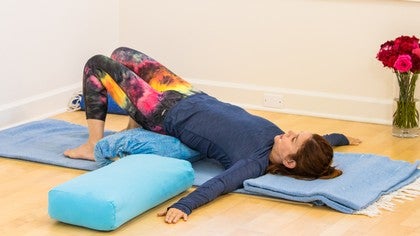Relaxation Takes Practice: Delicious and Deep Restore
Leeann Carey
Watch this Practice

Marleen R
A lovely way to start my week and counter my usual Monday manic mind. Thank you Leeann.
9 years ago
I prefer scooching away from the bolster after Viparita + rest legs over bolster to go into savasana, instead of coming upright between, less disturbing of the quietude thats been cultivated.
8 years ago
Cicero, thank you so much for sharing how you like to exit this posture. So many different ways to do everything, huh? xok
8 years ago
If one were to "improve" restorative yoga, what might be some of the things needed to cover? Please don't misread this, I think there is always room for improvement; I am just to new to know where one might begin. I hope this makes sense. Ben
8 years ago
Agreed, Cicero. Sometimes I like to scooch (gosh, I LOVE that word -- so perfect for restorative yoga!) away from Viparita, too. And when I do that, it's done slowly. If you haven't already, consider scooching away so that the entire lower legs are resting on the bolster. Wait about a minute or so until you feel inspired to move again. Then scooch away so that only the middle calfs are resting on the bolster. Pause. Then scooch away so that only the heel bones are resting on the bolster. When you feel inspired to move, or IF you feel inspired to move, take your Savasana without any support. Give a try and let me know what your experience is like. XOX LC
8 years ago
Hi Ben, Thanks for commenting on restorative yoga again. Are you asking how to make your relaxation deeper? If so, this is a layered ?. In my humble opinion, there are two things that make ALL practice better and to meet uinque needs:
8 years ago
Ben: 1. Strategic prop placement. Set-up must make you feel "aahh" while in the pose. 2. The sequencing needs to make sense. That's achieved by sequencing poses in relation to the effect they have on the nervous system. I.E. the "loud" poses (backbends & supine twists) are to be placed at the top of the practice, the "quiet" poses (prone twists, simple inversions (such as Legs Up The Wall or Legs Up The Chair, forward bends of all kinds are to be placed toward the end, and the "neutral" poses such as Child Pose can be be placed at the top of practice & a bridge between finishing the loud poses & starting the quiet poses.
8 years ago
1-10 of 17
You need to be a subscriber to post a comment.
Please Log In or Create an Account to start your free trial.












